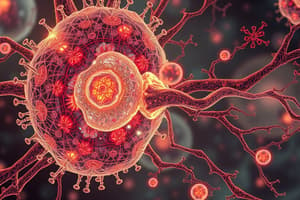Podcast
Questions and Answers
Match the following components with their roles in signal transduction pathways:
Match the following components with their roles in signal transduction pathways:
Receptors = Receive extracellular signals Kinases = Modify protein activity GTPases = Act as regulatory molecules Phosphorylation events = Initiate changes to cell shape
Match the following signal transduction pathways with their primary functions:
Match the following signal transduction pathways with their primary functions:
cAMP/PKA pathway = Modifying insulin sensitivity and glycogen synthesis Wnt/β-catenin pathway = Regulating cellular processes like proliferation and differentiation PI3K/AKT/mTOR pathway = Controlling cell growth, survival, and metabolism
Match the following descriptions with the correct definition:
Match the following descriptions with the correct definition:
Signal transduction = Conversion of extracellular signals into intracellular responses Protein Kinase A (PKA) = Part of the cAMP signaling pathway involved in energy metabolism
Match the following signaling pathways with their relevant targets:
Match the following signaling pathways with their relevant targets:
Match the following activating factors with their respective signaling pathways:
Match the following activating factors with their respective signaling pathways:
Match the following diseases with the signaling pathways implicated in them:
Match the following diseases with the signaling pathways implicated in them:
Flashcards are hidden until you start studying
Study Notes
Cell Signaling in Liver Cells: Exploring Pathways of Communication
Liver cells, also known as hepatocytes, serve numerous vital functions within our bodies. Maintaining cellular health, regulating metabolism, detoxifying chemicals—these tasks rely heavily upon efficient communication via intricate systems called signal transduction pathways. In this exploration into cell signaling within liver cells, we'll delve deeper into these critical pathways, their components, and their roles in overall hepatic function.
What Are Signal Transduction Pathways?
Signal transduction refers to the conversion of extracellular signals into intracellular responses, which often involve proteins acting successively as a relay chain to convey information from outside a cell to its interior. These chains typically consist of receptors, kinases, and other regulatory molecules like GTPases. These messengers can alter gene expression, modify protein activity, or even initiate changes to cell shape through phosphorylation events.
Key Signal Transduction Pathways in Hepatocytes
While several broad categories of pathways exist throughout human cells, three primary ones dominate liver cell interactions: cAMP/PKA, Wnt/β-catenin, and PI3K/AKT/mTOR. Here is a brief overview of each:
-
Cyclic AMP-Protein Kinase A (cAMP/PKA) pathway This pathway plays a pivotal role in energy metabolism as well as glucose homeostasis by modifying insulin sensitivity and glycogen synthesis.
-
Activating factors: Epinephrine, norepinephrine, thyroid hormones, cortisol, and glucagon all contribute to stimulation in healthy livers.
-
Receptor: Hormone sensitive lipase (HSL), perilipin, and glycerol-3-phosphate dehydrogenase (GPDH) release fatty acids and convert them into usable forms following activation.
-
-
Wnt/β-Catenin pathway Involved in stem cell renewal, tissue regeneration, and organ development processes, this pathway has been implicated in various diseases such as cirrhosis and cancer.
-
Activating factors: WNT ligands bind to Frizzled (FZD) family members, leading to disruption of the destruction complex containing Axin and β-catenin, allowing β-catenin accumulation and subsequent translocation into nucleus and promotion of target genes expression.
-
Relevant targets: Genes involved in inflammation, fibrosis, apoptosis, epithelial-mesenchymal transition, and angiogenesis.
-
-
Phosphoinositide 3-kinase (PI3K)/Protein Kinase B (AKT)/Mammalian Target Of Rapamycin (mTOR) pathway Influential in cell growth, survival, proliferation, differentiation, and autophagy, dysregulated pathways have prompted interest in potential therapeutic strategies against non-alcoholic steatohepatitis, Alagille syndrome, and viral hepatitis.
-
Activating factors: Insulin-like Growth Factor (IGF)-I, EGF, PDGF, TNFα, IL-6, and many others actuate the pathway via activating catalytic subunits of class I PI3K enzyme.
-
Relevant targets: mRNA translation regulators, ribosomal biogenesis machinery, lysosomal biogenesis, and autophagy control elements.
-
These well-defined signaling pathways play integral roles in maintaining normal liver physiology. However, they must remain tightly controlled because uncontrolled signaling may lead to life-altering conditions such as fibrogenesis, tumorigenesis, and chronic inflammatory states.
Understanding these essential mechanisms allows scientists to investigate the underpinnings of liver disease, develop targeted therapies, and improve patient care. By studying the nuances of liver cell signaling, researchers seek new insights into protecting the health of this remarkable organ and the individuals it serves daily..
Studying That Suits You
Use AI to generate personalized quizzes and flashcards to suit your learning preferences.




